Corporate Finance: AASB/IAS Accounting Standards Analysis Report
VerifiedAdded on 2023/04/23
|11
|2504
|163
Report
AI Summary
This assignment, prepared as a business letter, provides a detailed analysis of corporate finance issues, specifically focusing on the application of various accounting standards. The report addresses key concerns related to AASB 136/IAS 36 (Impairment of Assets), AASB 118/IAS 18 (Revenue Recognition), and IAS 37 (Contingent Assets and Liabilities). The student analyzes a scenario where a company faces challenges in accurately representing its financial position due to the application of these standards. The assignment offers suggestions for proper accounting disclosures, mitigation strategies, and decision-making processes, providing insights into how the company should account for these issues in their annual reports. Specific issues such as the treatment of impairment losses, the impact of revenue recognition methods, and the disclosure of contingent liabilities are thoroughly examined, with recommendations to ensure accurate and transparent financial reporting. The student emphasizes the importance of providing users with correct information and making appropriate disclosures to maintain the integrity of the financial statements.

Paraphrase This Document
Need a fresh take? Get an instant paraphrase of this document with our AI Paraphraser
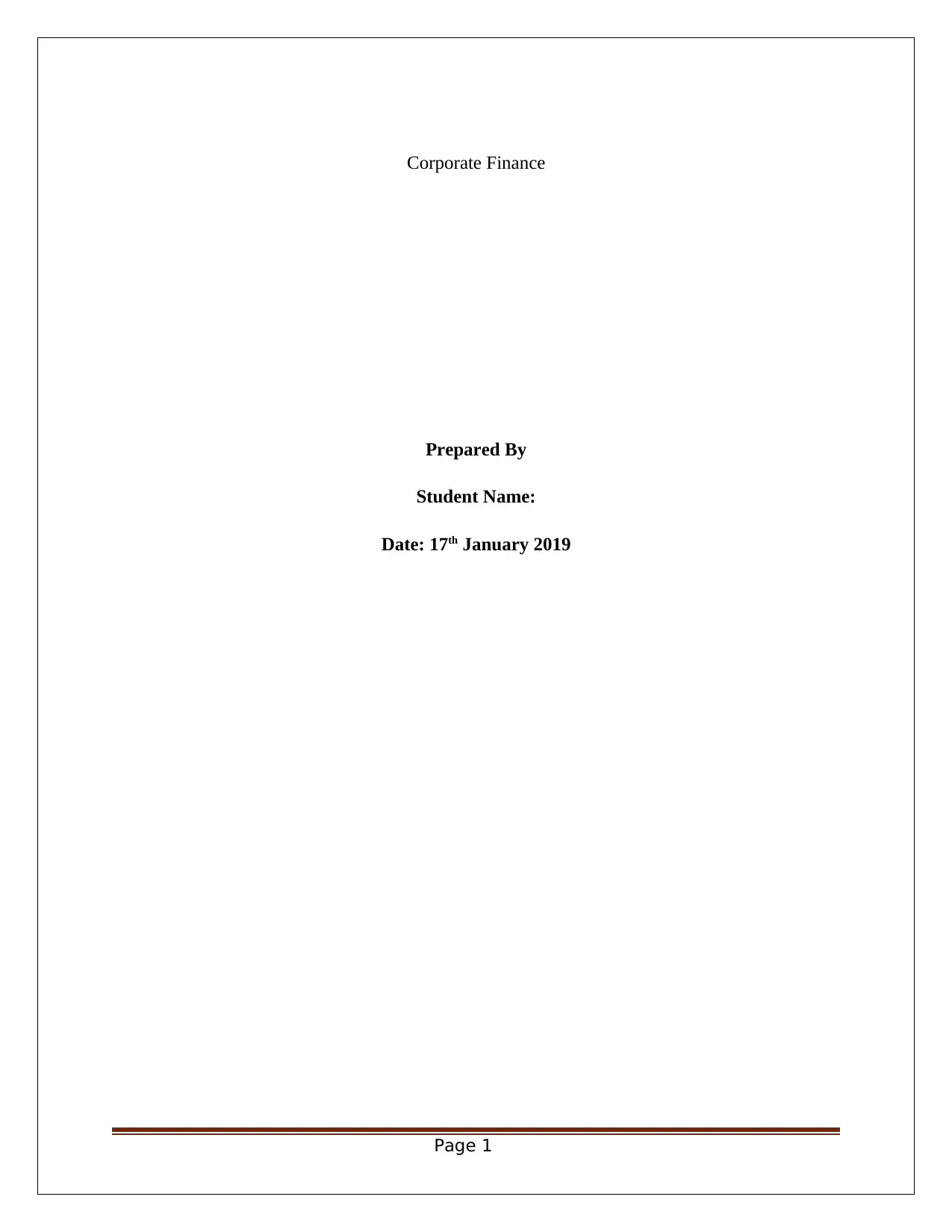
Corporate Finance
Prepared By
Student Name:
Date: 17th January 2019
Page 1
Prepared By
Student Name:
Date: 17th January 2019
Page 1
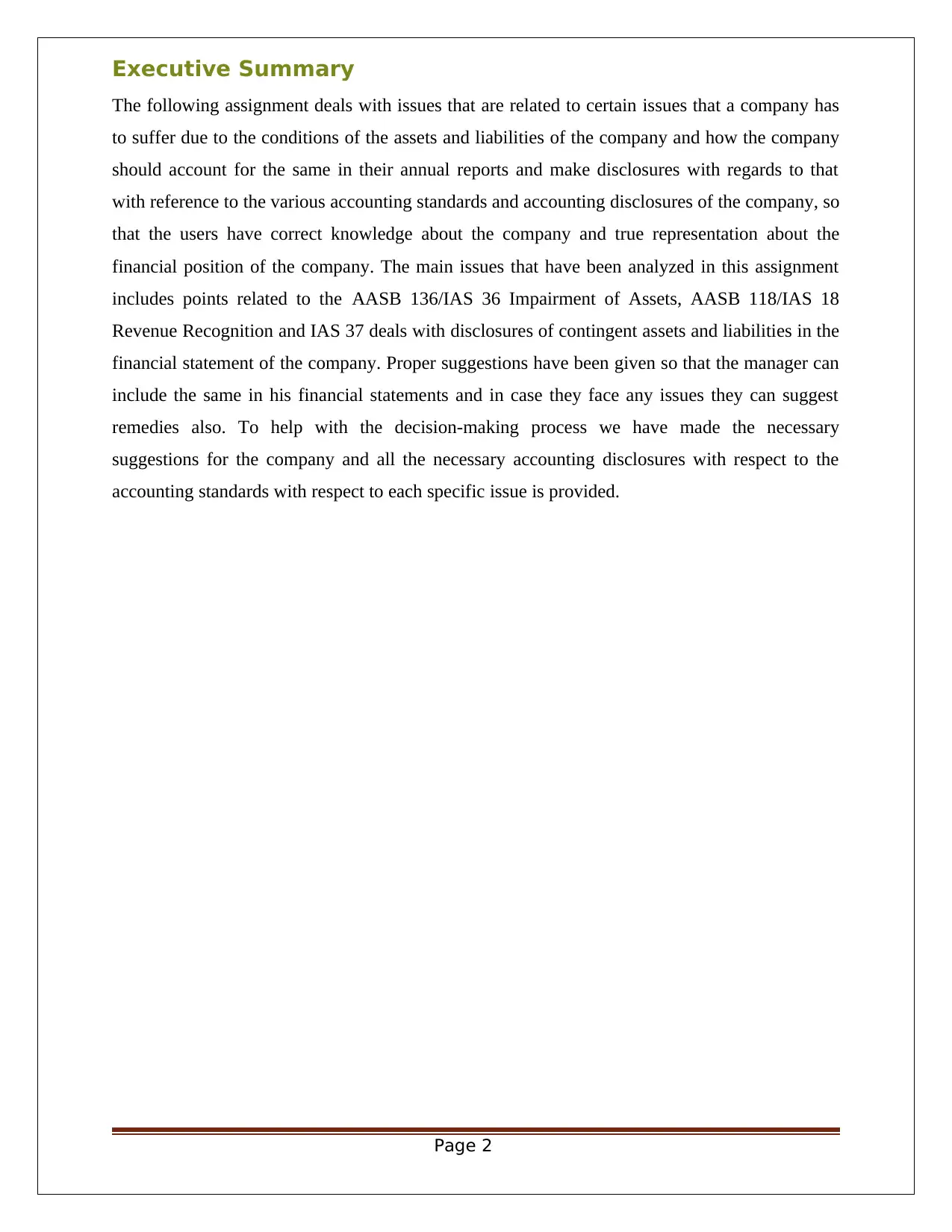
Executive Summary
The following assignment deals with issues that are related to certain issues that a company has
to suffer due to the conditions of the assets and liabilities of the company and how the company
should account for the same in their annual reports and make disclosures with regards to that
with reference to the various accounting standards and accounting disclosures of the company, so
that the users have correct knowledge about the company and true representation about the
financial position of the company. The main issues that have been analyzed in this assignment
includes points related to the AASB 136/IAS 36 Impairment of Assets, AASB 118/IAS 18
Revenue Recognition and IAS 37 deals with disclosures of contingent assets and liabilities in the
financial statement of the company. Proper suggestions have been given so that the manager can
include the same in his financial statements and in case they face any issues they can suggest
remedies also. To help with the decision-making process we have made the necessary
suggestions for the company and all the necessary accounting disclosures with respect to the
accounting standards with respect to each specific issue is provided.
Page 2
The following assignment deals with issues that are related to certain issues that a company has
to suffer due to the conditions of the assets and liabilities of the company and how the company
should account for the same in their annual reports and make disclosures with regards to that
with reference to the various accounting standards and accounting disclosures of the company, so
that the users have correct knowledge about the company and true representation about the
financial position of the company. The main issues that have been analyzed in this assignment
includes points related to the AASB 136/IAS 36 Impairment of Assets, AASB 118/IAS 18
Revenue Recognition and IAS 37 deals with disclosures of contingent assets and liabilities in the
financial statement of the company. Proper suggestions have been given so that the manager can
include the same in his financial statements and in case they face any issues they can suggest
remedies also. To help with the decision-making process we have made the necessary
suggestions for the company and all the necessary accounting disclosures with respect to the
accounting standards with respect to each specific issue is provided.
Page 2
⊘ This is a preview!⊘
Do you want full access?
Subscribe today to unlock all pages.

Trusted by 1+ million students worldwide
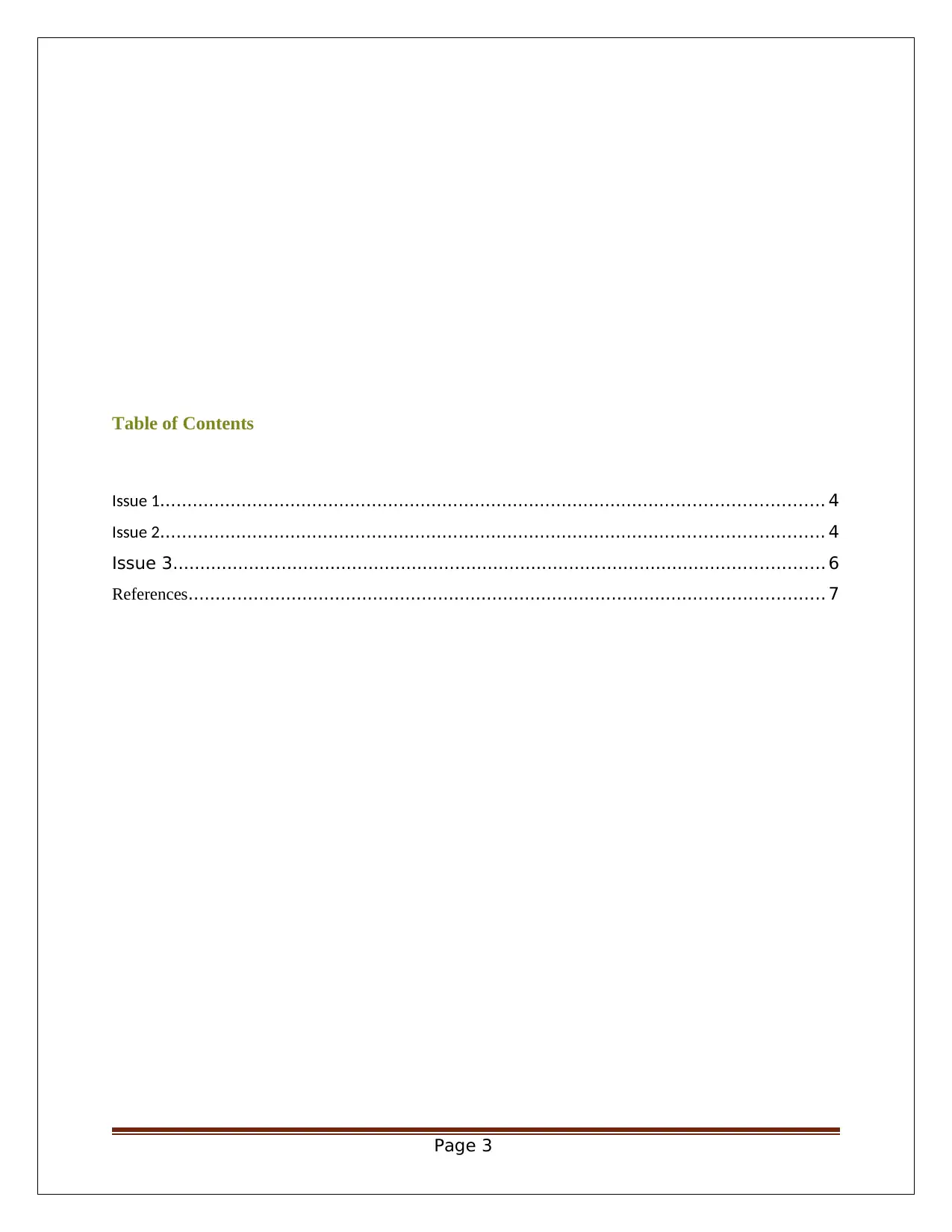
Table of Contents
Issue 1.......................................................................................................................... 4
Issue 2.......................................................................................................................... 4
Issue 3........................................................................................................................ 6
References..................................................................................................................... 7
Page 3
Issue 1.......................................................................................................................... 4
Issue 2.......................................................................................................................... 4
Issue 3........................................................................................................................ 6
References..................................................................................................................... 7
Page 3
Paraphrase This Document
Need a fresh take? Get an instant paraphrase of this document with our AI Paraphraser
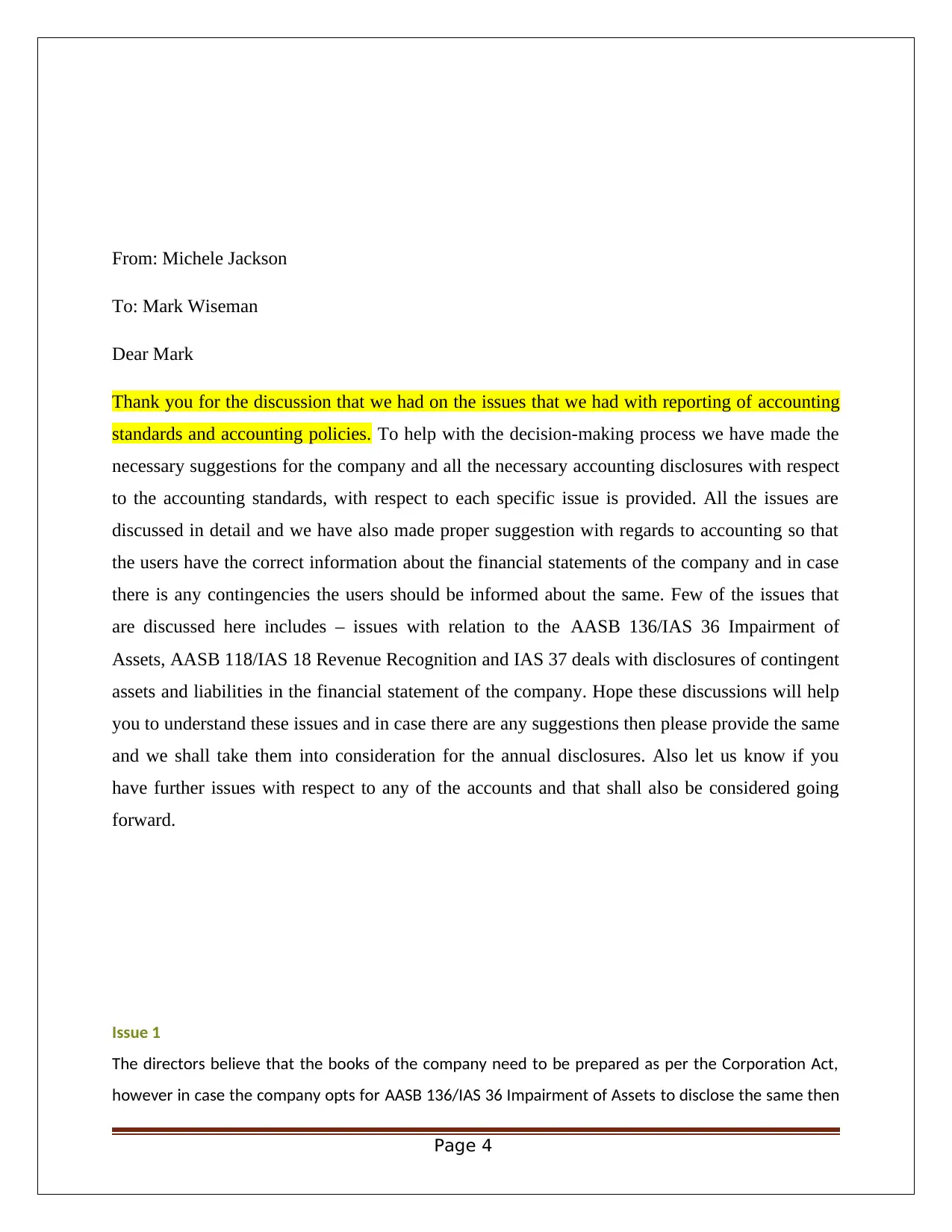
From: Michele Jackson
To: Mark Wiseman
Dear Mark
Thank you for the discussion that we had on the issues that we had with reporting of accounting
standards and accounting policies. To help with the decision-making process we have made the
necessary suggestions for the company and all the necessary accounting disclosures with respect
to the accounting standards, with respect to each specific issue is provided. All the issues are
discussed in detail and we have also made proper suggestion with regards to accounting so that
the users have the correct information about the financial statements of the company and in case
there is any contingencies the users should be informed about the same. Few of the issues that
are discussed here includes – issues with relation to the AASB 136/IAS 36 Impairment of
Assets, AASB 118/IAS 18 Revenue Recognition and IAS 37 deals with disclosures of contingent
assets and liabilities in the financial statement of the company. Hope these discussions will help
you to understand these issues and in case there are any suggestions then please provide the same
and we shall take them into consideration for the annual disclosures. Also let us know if you
have further issues with respect to any of the accounts and that shall also be considered going
forward.
Issue 1
The directors believe that the books of the company need to be prepared as per the Corporation Act,
however in case the company opts for AASB 136/IAS 36 Impairment of Assets to disclose the same then
Page 4
To: Mark Wiseman
Dear Mark
Thank you for the discussion that we had on the issues that we had with reporting of accounting
standards and accounting policies. To help with the decision-making process we have made the
necessary suggestions for the company and all the necessary accounting disclosures with respect
to the accounting standards, with respect to each specific issue is provided. All the issues are
discussed in detail and we have also made proper suggestion with regards to accounting so that
the users have the correct information about the financial statements of the company and in case
there is any contingencies the users should be informed about the same. Few of the issues that
are discussed here includes – issues with relation to the AASB 136/IAS 36 Impairment of
Assets, AASB 118/IAS 18 Revenue Recognition and IAS 37 deals with disclosures of contingent
assets and liabilities in the financial statement of the company. Hope these discussions will help
you to understand these issues and in case there are any suggestions then please provide the same
and we shall take them into consideration for the annual disclosures. Also let us know if you
have further issues with respect to any of the accounts and that shall also be considered going
forward.
Issue 1
The directors believe that the books of the company need to be prepared as per the Corporation Act,
however in case the company opts for AASB 136/IAS 36 Impairment of Assets to disclose the same then
Page 4
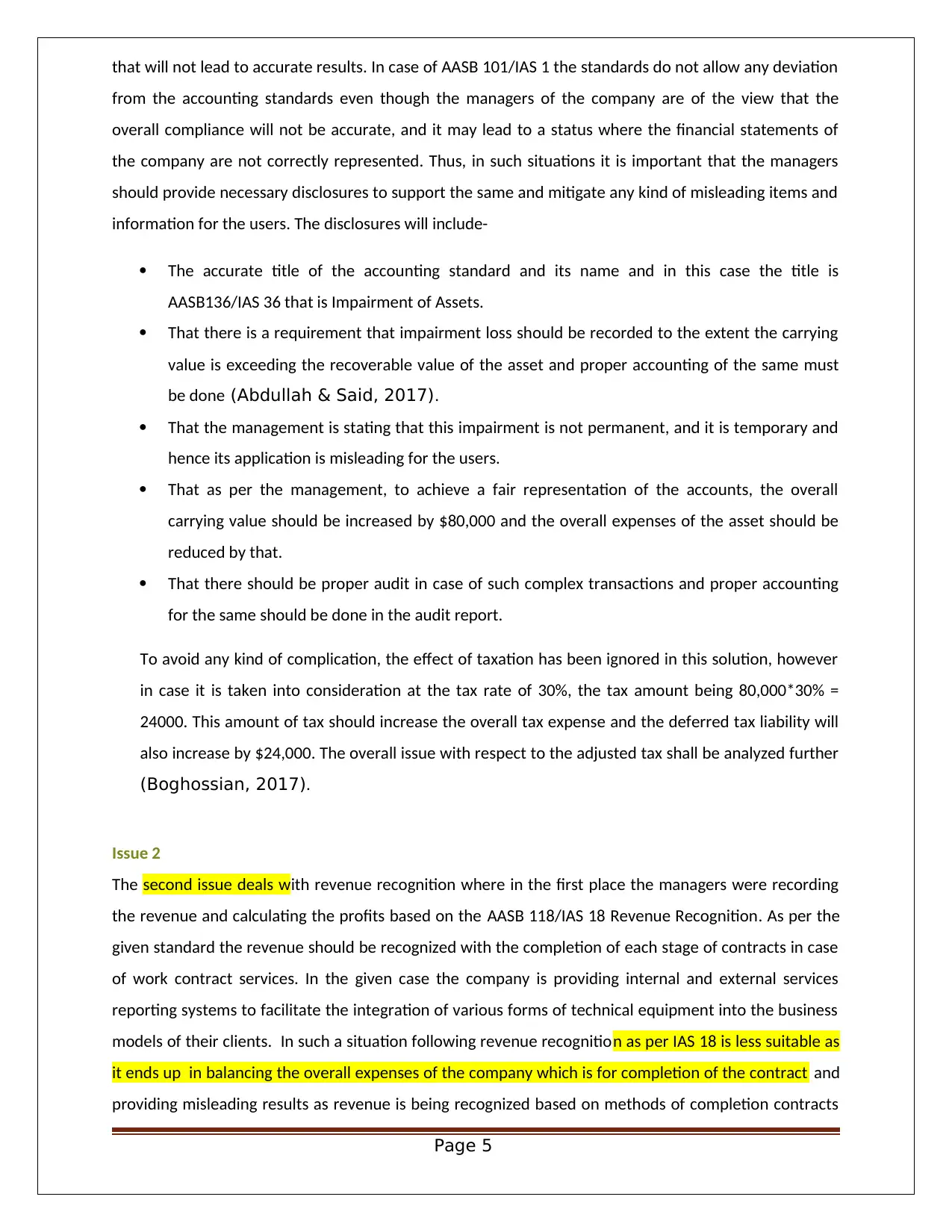
that will not lead to accurate results. In case of AASB 101/IAS 1 the standards do not allow any deviation
from the accounting standards even though the managers of the company are of the view that the
overall compliance will not be accurate, and it may lead to a status where the financial statements of
the company are not correctly represented. Thus, in such situations it is important that the managers
should provide necessary disclosures to support the same and mitigate any kind of misleading items and
information for the users. The disclosures will include-
The accurate title of the accounting standard and its name and in this case the title is
AASB136/IAS 36 that is Impairment of Assets.
That there is a requirement that impairment loss should be recorded to the extent the carrying
value is exceeding the recoverable value of the asset and proper accounting of the same must
be done (Abdullah & Said, 2017).
That the management is stating that this impairment is not permanent, and it is temporary and
hence its application is misleading for the users.
That as per the management, to achieve a fair representation of the accounts, the overall
carrying value should be increased by $80,000 and the overall expenses of the asset should be
reduced by that.
That there should be proper audit in case of such complex transactions and proper accounting
for the same should be done in the audit report.
To avoid any kind of complication, the effect of taxation has been ignored in this solution, however
in case it is taken into consideration at the tax rate of 30%, the tax amount being 80,000*30% =
24000. This amount of tax should increase the overall tax expense and the deferred tax liability will
also increase by $24,000. The overall issue with respect to the adjusted tax shall be analyzed further
(Boghossian, 2017).
Issue 2
The second issue deals with revenue recognition where in the first place the managers were recording
the revenue and calculating the profits based on the AASB 118/IAS 18 Revenue Recognition. As per the
given standard the revenue should be recognized with the completion of each stage of contracts in case
of work contract services. In the given case the company is providing internal and external services
reporting systems to facilitate the integration of various forms of technical equipment into the business
models of their clients. In such a situation following revenue recognition as per IAS 18 is less suitable as
it ends up in balancing the overall expenses of the company which is for completion of the contract and
providing misleading results as revenue is being recognized based on methods of completion contracts
Page 5
from the accounting standards even though the managers of the company are of the view that the
overall compliance will not be accurate, and it may lead to a status where the financial statements of
the company are not correctly represented. Thus, in such situations it is important that the managers
should provide necessary disclosures to support the same and mitigate any kind of misleading items and
information for the users. The disclosures will include-
The accurate title of the accounting standard and its name and in this case the title is
AASB136/IAS 36 that is Impairment of Assets.
That there is a requirement that impairment loss should be recorded to the extent the carrying
value is exceeding the recoverable value of the asset and proper accounting of the same must
be done (Abdullah & Said, 2017).
That the management is stating that this impairment is not permanent, and it is temporary and
hence its application is misleading for the users.
That as per the management, to achieve a fair representation of the accounts, the overall
carrying value should be increased by $80,000 and the overall expenses of the asset should be
reduced by that.
That there should be proper audit in case of such complex transactions and proper accounting
for the same should be done in the audit report.
To avoid any kind of complication, the effect of taxation has been ignored in this solution, however
in case it is taken into consideration at the tax rate of 30%, the tax amount being 80,000*30% =
24000. This amount of tax should increase the overall tax expense and the deferred tax liability will
also increase by $24,000. The overall issue with respect to the adjusted tax shall be analyzed further
(Boghossian, 2017).
Issue 2
The second issue deals with revenue recognition where in the first place the managers were recording
the revenue and calculating the profits based on the AASB 118/IAS 18 Revenue Recognition. As per the
given standard the revenue should be recognized with the completion of each stage of contracts in case
of work contract services. In the given case the company is providing internal and external services
reporting systems to facilitate the integration of various forms of technical equipment into the business
models of their clients. In such a situation following revenue recognition as per IAS 18 is less suitable as
it ends up in balancing the overall expenses of the company which is for completion of the contract and
providing misleading results as revenue is being recognized based on methods of completion contracts
Page 5
⊘ This is a preview!⊘
Do you want full access?
Subscribe today to unlock all pages.

Trusted by 1+ million students worldwide
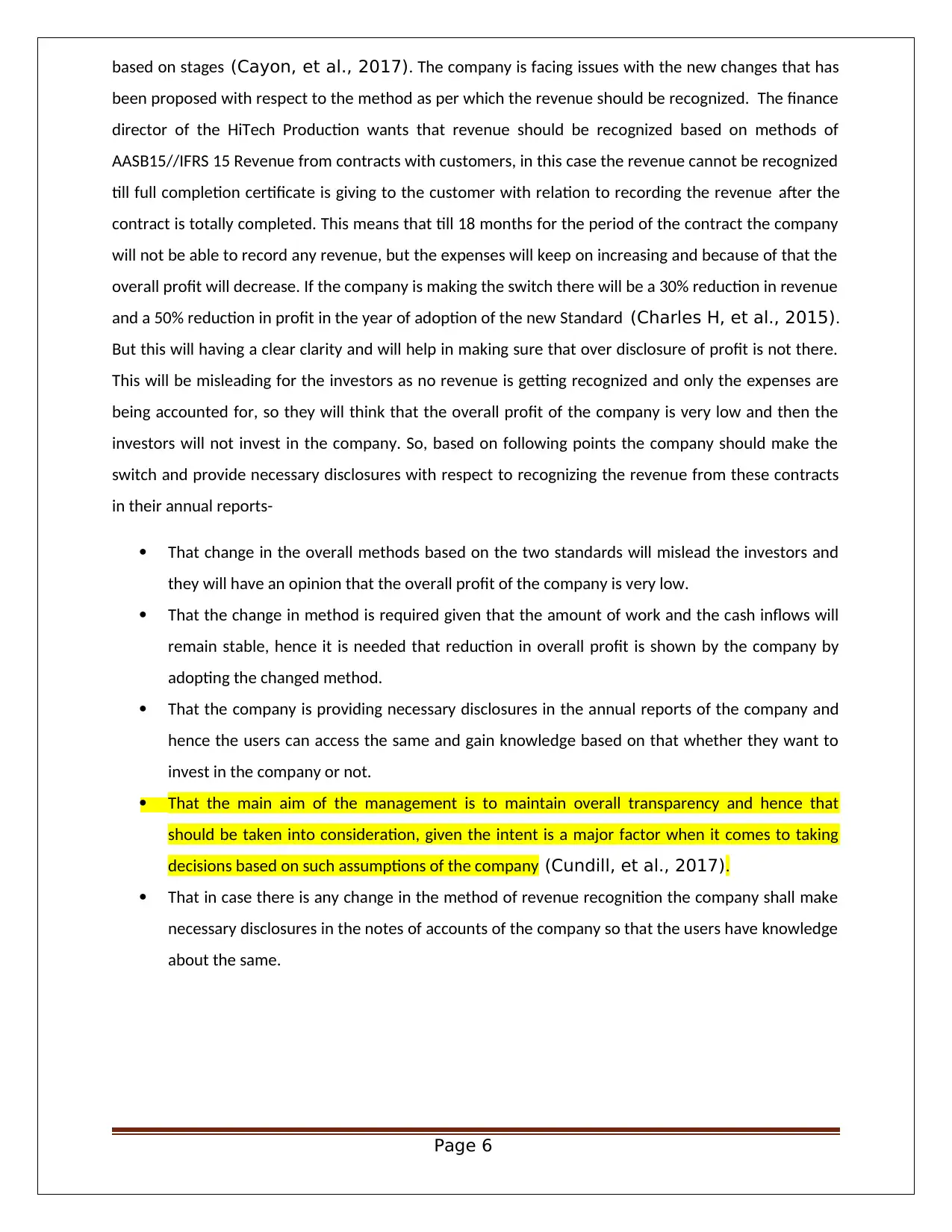
based on stages (Cayon, et al., 2017). The company is facing issues with the new changes that has
been proposed with respect to the method as per which the revenue should be recognized. The finance
director of the HiTech Production wants that revenue should be recognized based on methods of
AASB15//IFRS 15 Revenue from contracts with customers, in this case the revenue cannot be recognized
till full completion certificate is giving to the customer with relation to recording the revenue after the
contract is totally completed. This means that till 18 months for the period of the contract the company
will not be able to record any revenue, but the expenses will keep on increasing and because of that the
overall profit will decrease. If the company is making the switch there will be a 30% reduction in revenue
and a 50% reduction in profit in the year of adoption of the new Standard (Charles H, et al., 2015).
But this will having a clear clarity and will help in making sure that over disclosure of profit is not there.
This will be misleading for the investors as no revenue is getting recognized and only the expenses are
being accounted for, so they will think that the overall profit of the company is very low and then the
investors will not invest in the company. So, based on following points the company should make the
switch and provide necessary disclosures with respect to recognizing the revenue from these contracts
in their annual reports-
That change in the overall methods based on the two standards will mislead the investors and
they will have an opinion that the overall profit of the company is very low.
That the change in method is required given that the amount of work and the cash inflows will
remain stable, hence it is needed that reduction in overall profit is shown by the company by
adopting the changed method.
That the company is providing necessary disclosures in the annual reports of the company and
hence the users can access the same and gain knowledge based on that whether they want to
invest in the company or not.
That the main aim of the management is to maintain overall transparency and hence that
should be taken into consideration, given the intent is a major factor when it comes to taking
decisions based on such assumptions of the company (Cundill, et al., 2017).
That in case there is any change in the method of revenue recognition the company shall make
necessary disclosures in the notes of accounts of the company so that the users have knowledge
about the same.
Page 6
been proposed with respect to the method as per which the revenue should be recognized. The finance
director of the HiTech Production wants that revenue should be recognized based on methods of
AASB15//IFRS 15 Revenue from contracts with customers, in this case the revenue cannot be recognized
till full completion certificate is giving to the customer with relation to recording the revenue after the
contract is totally completed. This means that till 18 months for the period of the contract the company
will not be able to record any revenue, but the expenses will keep on increasing and because of that the
overall profit will decrease. If the company is making the switch there will be a 30% reduction in revenue
and a 50% reduction in profit in the year of adoption of the new Standard (Charles H, et al., 2015).
But this will having a clear clarity and will help in making sure that over disclosure of profit is not there.
This will be misleading for the investors as no revenue is getting recognized and only the expenses are
being accounted for, so they will think that the overall profit of the company is very low and then the
investors will not invest in the company. So, based on following points the company should make the
switch and provide necessary disclosures with respect to recognizing the revenue from these contracts
in their annual reports-
That change in the overall methods based on the two standards will mislead the investors and
they will have an opinion that the overall profit of the company is very low.
That the change in method is required given that the amount of work and the cash inflows will
remain stable, hence it is needed that reduction in overall profit is shown by the company by
adopting the changed method.
That the company is providing necessary disclosures in the annual reports of the company and
hence the users can access the same and gain knowledge based on that whether they want to
invest in the company or not.
That the main aim of the management is to maintain overall transparency and hence that
should be taken into consideration, given the intent is a major factor when it comes to taking
decisions based on such assumptions of the company (Cundill, et al., 2017).
That in case there is any change in the method of revenue recognition the company shall make
necessary disclosures in the notes of accounts of the company so that the users have knowledge
about the same.
Page 6
Paraphrase This Document
Need a fresh take? Get an instant paraphrase of this document with our AI Paraphraser
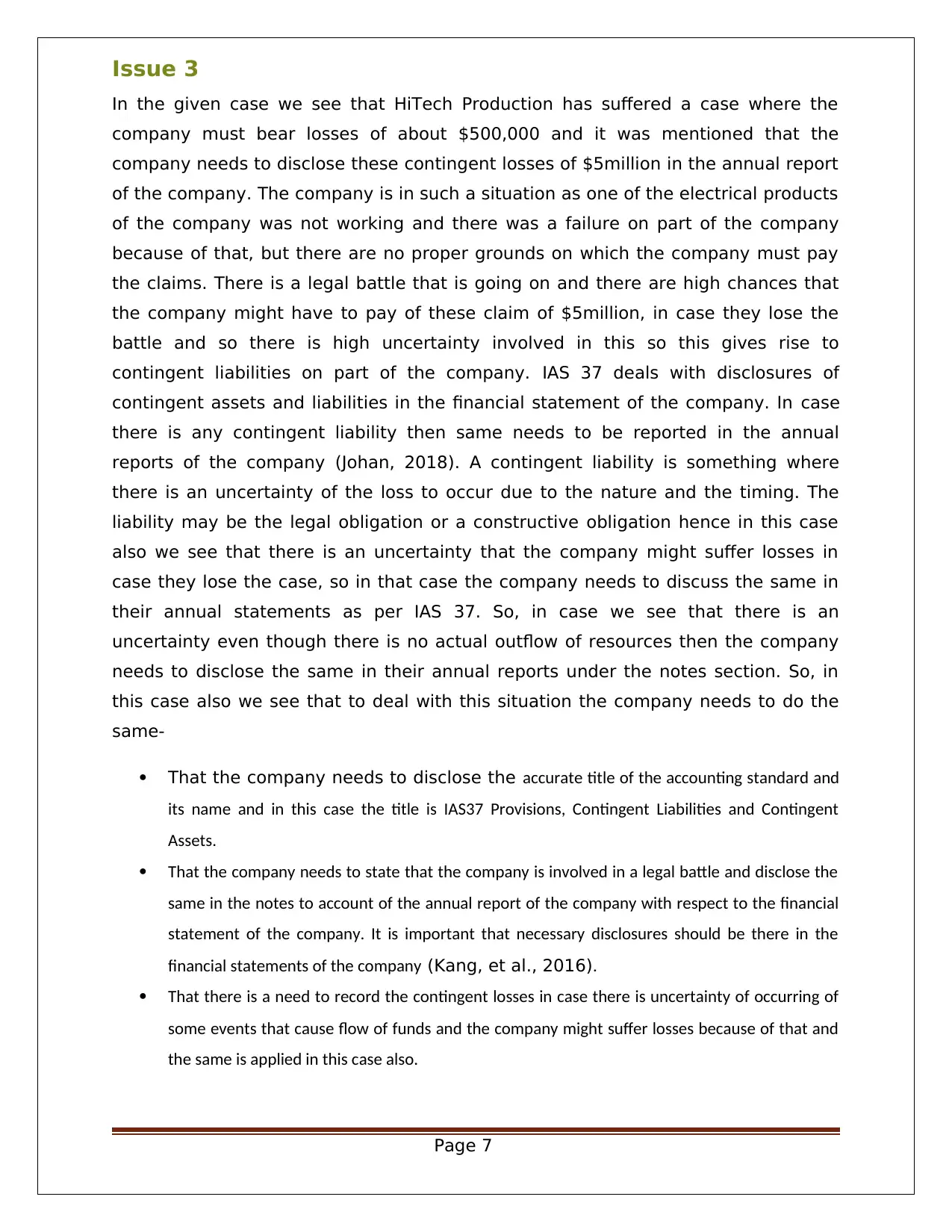
Issue 3
In the given case we see that HiTech Production has suffered a case where the
company must bear losses of about $500,000 and it was mentioned that the
company needs to disclose these contingent losses of $5million in the annual report
of the company. The company is in such a situation as one of the electrical products
of the company was not working and there was a failure on part of the company
because of that, but there are no proper grounds on which the company must pay
the claims. There is a legal battle that is going on and there are high chances that
the company might have to pay of these claim of $5million, in case they lose the
battle and so there is high uncertainty involved in this so this gives rise to
contingent liabilities on part of the company. IAS 37 deals with disclosures of
contingent assets and liabilities in the financial statement of the company. In case
there is any contingent liability then same needs to be reported in the annual
reports of the company (Johan, 2018). A contingent liability is something where
there is an uncertainty of the loss to occur due to the nature and the timing. The
liability may be the legal obligation or a constructive obligation hence in this case
also we see that there is an uncertainty that the company might suffer losses in
case they lose the case, so in that case the company needs to discuss the same in
their annual statements as per IAS 37. So, in case we see that there is an
uncertainty even though there is no actual outflow of resources then the company
needs to disclose the same in their annual reports under the notes section. So, in
this case also we see that to deal with this situation the company needs to do the
same-
That the company needs to disclose the accurate title of the accounting standard and
its name and in this case the title is IAS37 Provisions, Contingent Liabilities and Contingent
Assets.
That the company needs to state that the company is involved in a legal battle and disclose the
same in the notes to account of the annual report of the company with respect to the financial
statement of the company. It is important that necessary disclosures should be there in the
financial statements of the company (Kang, et al., 2016).
That there is a need to record the contingent losses in case there is uncertainty of occurring of
some events that cause flow of funds and the company might suffer losses because of that and
the same is applied in this case also.
Page 7
In the given case we see that HiTech Production has suffered a case where the
company must bear losses of about $500,000 and it was mentioned that the
company needs to disclose these contingent losses of $5million in the annual report
of the company. The company is in such a situation as one of the electrical products
of the company was not working and there was a failure on part of the company
because of that, but there are no proper grounds on which the company must pay
the claims. There is a legal battle that is going on and there are high chances that
the company might have to pay of these claim of $5million, in case they lose the
battle and so there is high uncertainty involved in this so this gives rise to
contingent liabilities on part of the company. IAS 37 deals with disclosures of
contingent assets and liabilities in the financial statement of the company. In case
there is any contingent liability then same needs to be reported in the annual
reports of the company (Johan, 2018). A contingent liability is something where
there is an uncertainty of the loss to occur due to the nature and the timing. The
liability may be the legal obligation or a constructive obligation hence in this case
also we see that there is an uncertainty that the company might suffer losses in
case they lose the case, so in that case the company needs to discuss the same in
their annual statements as per IAS 37. So, in case we see that there is an
uncertainty even though there is no actual outflow of resources then the company
needs to disclose the same in their annual reports under the notes section. So, in
this case also we see that to deal with this situation the company needs to do the
same-
That the company needs to disclose the accurate title of the accounting standard and
its name and in this case the title is IAS37 Provisions, Contingent Liabilities and Contingent
Assets.
That the company needs to state that the company is involved in a legal battle and disclose the
same in the notes to account of the annual report of the company with respect to the financial
statement of the company. It is important that necessary disclosures should be there in the
financial statements of the company (Kang, et al., 2016).
That there is a need to record the contingent losses in case there is uncertainty of occurring of
some events that cause flow of funds and the company might suffer losses because of that and
the same is applied in this case also.
Page 7
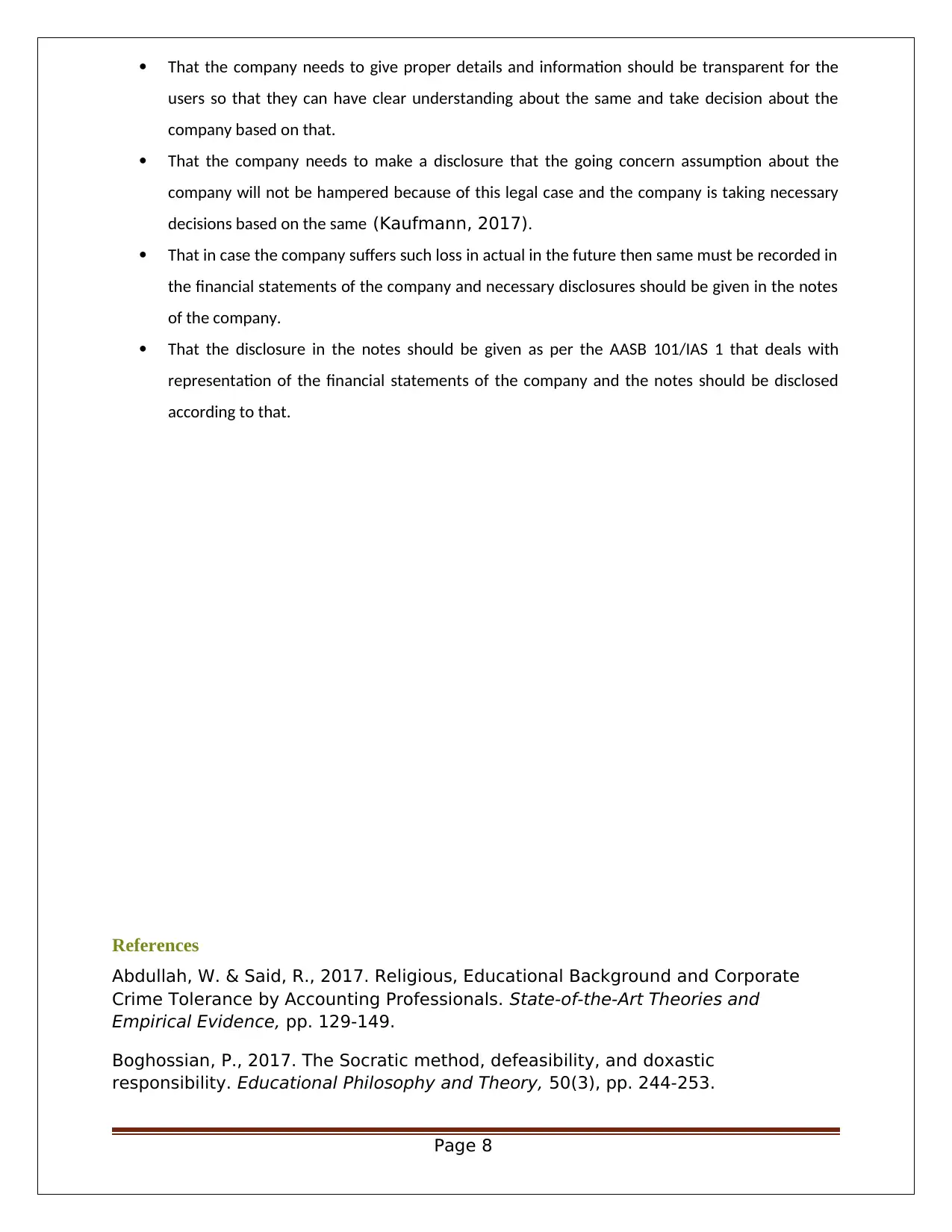
That the company needs to give proper details and information should be transparent for the
users so that they can have clear understanding about the same and take decision about the
company based on that.
That the company needs to make a disclosure that the going concern assumption about the
company will not be hampered because of this legal case and the company is taking necessary
decisions based on the same (Kaufmann, 2017).
That in case the company suffers such loss in actual in the future then same must be recorded in
the financial statements of the company and necessary disclosures should be given in the notes
of the company.
That the disclosure in the notes should be given as per the AASB 101/IAS 1 that deals with
representation of the financial statements of the company and the notes should be disclosed
according to that.
References
Abdullah, W. & Said, R., 2017. Religious, Educational Background and Corporate
Crime Tolerance by Accounting Professionals. State-of-the-Art Theories and
Empirical Evidence, pp. 129-149.
Boghossian, P., 2017. The Socratic method, defeasibility, and doxastic
responsibility. Educational Philosophy and Theory, 50(3), pp. 244-253.
Page 8
users so that they can have clear understanding about the same and take decision about the
company based on that.
That the company needs to make a disclosure that the going concern assumption about the
company will not be hampered because of this legal case and the company is taking necessary
decisions based on the same (Kaufmann, 2017).
That in case the company suffers such loss in actual in the future then same must be recorded in
the financial statements of the company and necessary disclosures should be given in the notes
of the company.
That the disclosure in the notes should be given as per the AASB 101/IAS 1 that deals with
representation of the financial statements of the company and the notes should be disclosed
according to that.
References
Abdullah, W. & Said, R., 2017. Religious, Educational Background and Corporate
Crime Tolerance by Accounting Professionals. State-of-the-Art Theories and
Empirical Evidence, pp. 129-149.
Boghossian, P., 2017. The Socratic method, defeasibility, and doxastic
responsibility. Educational Philosophy and Theory, 50(3), pp. 244-253.
Page 8
⊘ This is a preview!⊘
Do you want full access?
Subscribe today to unlock all pages.

Trusted by 1+ million students worldwide
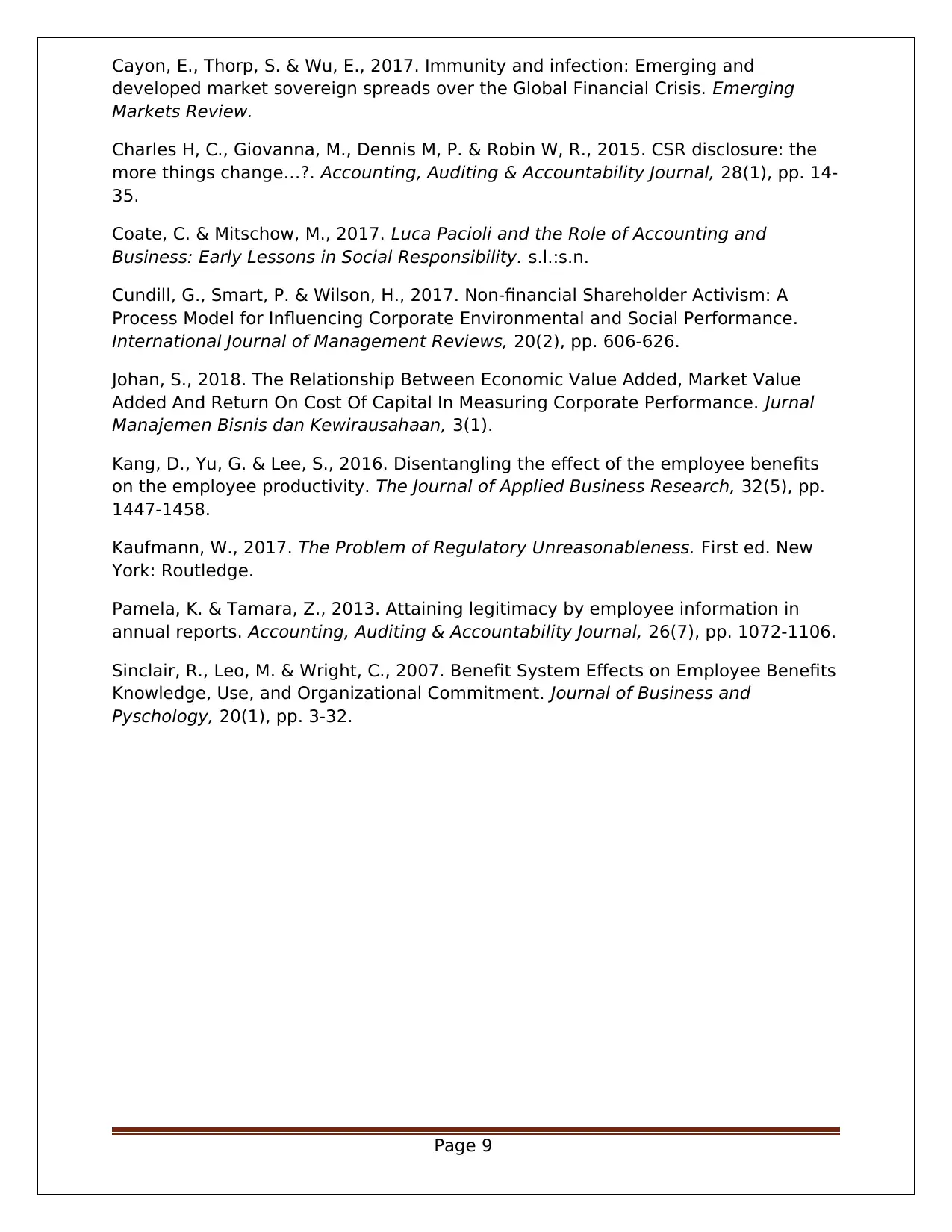
Cayon, E., Thorp, S. & Wu, E., 2017. Immunity and infection: Emerging and
developed market sovereign spreads over the Global Financial Crisis. Emerging
Markets Review.
Charles H, C., Giovanna, M., Dennis M, P. & Robin W, R., 2015. CSR disclosure: the
more things change…?. Accounting, Auditing & Accountability Journal, 28(1), pp. 14-
35.
Coate, C. & Mitschow, M., 2017. Luca Pacioli and the Role of Accounting and
Business: Early Lessons in Social Responsibility. s.l.:s.n.
Cundill, G., Smart, P. & Wilson, H., 2017. Non‐financial Shareholder Activism: A
Process Model for Influencing Corporate Environmental and Social Performance.
International Journal of Management Reviews, 20(2), pp. 606-626.
Johan, S., 2018. The Relationship Between Economic Value Added, Market Value
Added And Return On Cost Of Capital In Measuring Corporate Performance. Jurnal
Manajemen Bisnis dan Kewirausahaan, 3(1).
Kang, D., Yu, G. & Lee, S., 2016. Disentangling the effect of the employee benefits
on the employee productivity. The Journal of Applied Business Research, 32(5), pp.
1447-1458.
Kaufmann, W., 2017. The Problem of Regulatory Unreasonableness. First ed. New
York: Routledge.
Pamela, K. & Tamara, Z., 2013. Attaining legitimacy by employee information in
annual reports. Accounting, Auditing & Accountability Journal, 26(7), pp. 1072-1106.
Sinclair, R., Leo, M. & Wright, C., 2007. Benefit System Effects on Employee Benefits
Knowledge, Use, and Organizational Commitment. Journal of Business and
Pyschology, 20(1), pp. 3-32.
Page 9
developed market sovereign spreads over the Global Financial Crisis. Emerging
Markets Review.
Charles H, C., Giovanna, M., Dennis M, P. & Robin W, R., 2015. CSR disclosure: the
more things change…?. Accounting, Auditing & Accountability Journal, 28(1), pp. 14-
35.
Coate, C. & Mitschow, M., 2017. Luca Pacioli and the Role of Accounting and
Business: Early Lessons in Social Responsibility. s.l.:s.n.
Cundill, G., Smart, P. & Wilson, H., 2017. Non‐financial Shareholder Activism: A
Process Model for Influencing Corporate Environmental and Social Performance.
International Journal of Management Reviews, 20(2), pp. 606-626.
Johan, S., 2018. The Relationship Between Economic Value Added, Market Value
Added And Return On Cost Of Capital In Measuring Corporate Performance. Jurnal
Manajemen Bisnis dan Kewirausahaan, 3(1).
Kang, D., Yu, G. & Lee, S., 2016. Disentangling the effect of the employee benefits
on the employee productivity. The Journal of Applied Business Research, 32(5), pp.
1447-1458.
Kaufmann, W., 2017. The Problem of Regulatory Unreasonableness. First ed. New
York: Routledge.
Pamela, K. & Tamara, Z., 2013. Attaining legitimacy by employee information in
annual reports. Accounting, Auditing & Accountability Journal, 26(7), pp. 1072-1106.
Sinclair, R., Leo, M. & Wright, C., 2007. Benefit System Effects on Employee Benefits
Knowledge, Use, and Organizational Commitment. Journal of Business and
Pyschology, 20(1), pp. 3-32.
Page 9
Paraphrase This Document
Need a fresh take? Get an instant paraphrase of this document with our AI Paraphraser
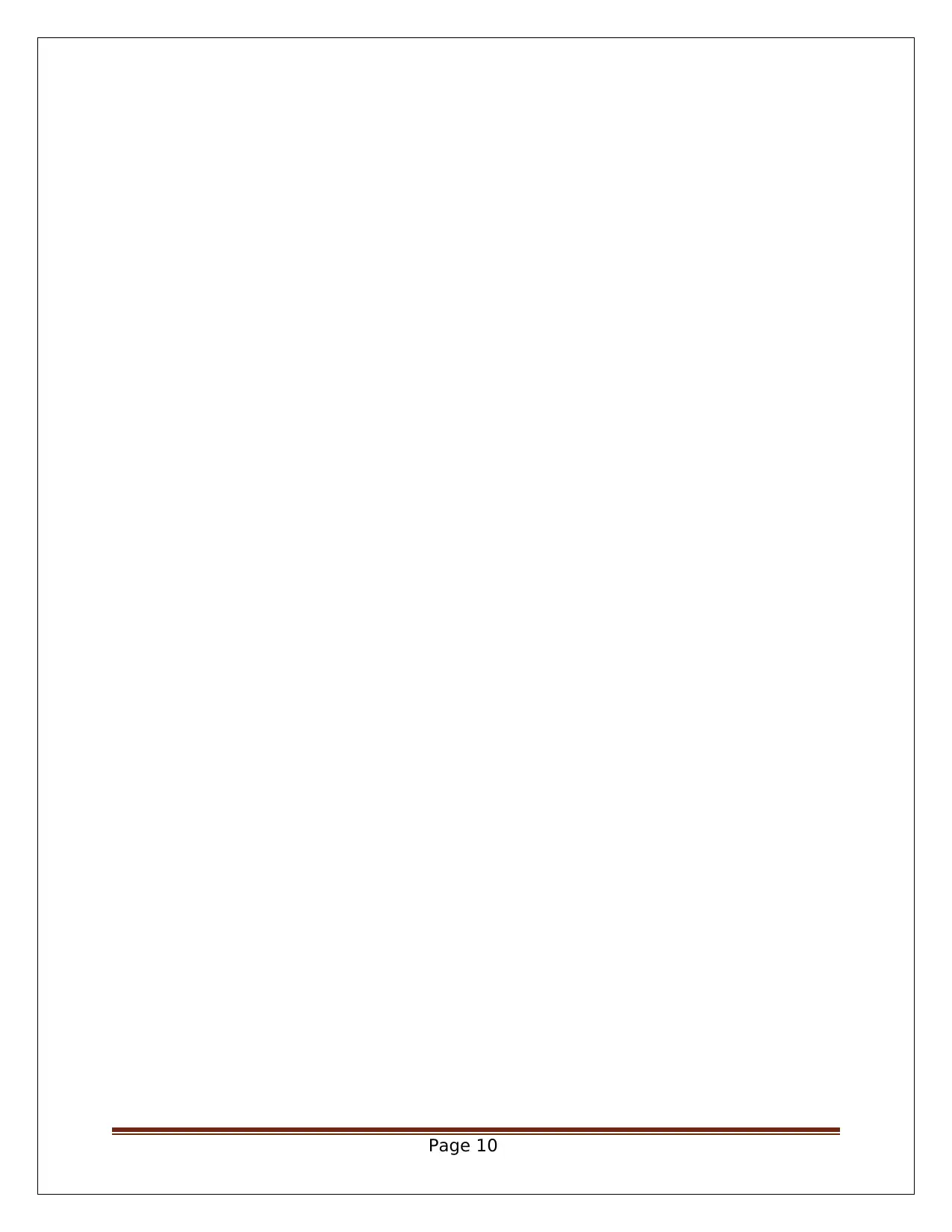
Page 10
1 out of 11
Related Documents
Your All-in-One AI-Powered Toolkit for Academic Success.
+13062052269
info@desklib.com
Available 24*7 on WhatsApp / Email
![[object Object]](/_next/static/media/star-bottom.7253800d.svg)
Unlock your academic potential
Copyright © 2020–2025 A2Z Services. All Rights Reserved. Developed and managed by ZUCOL.





